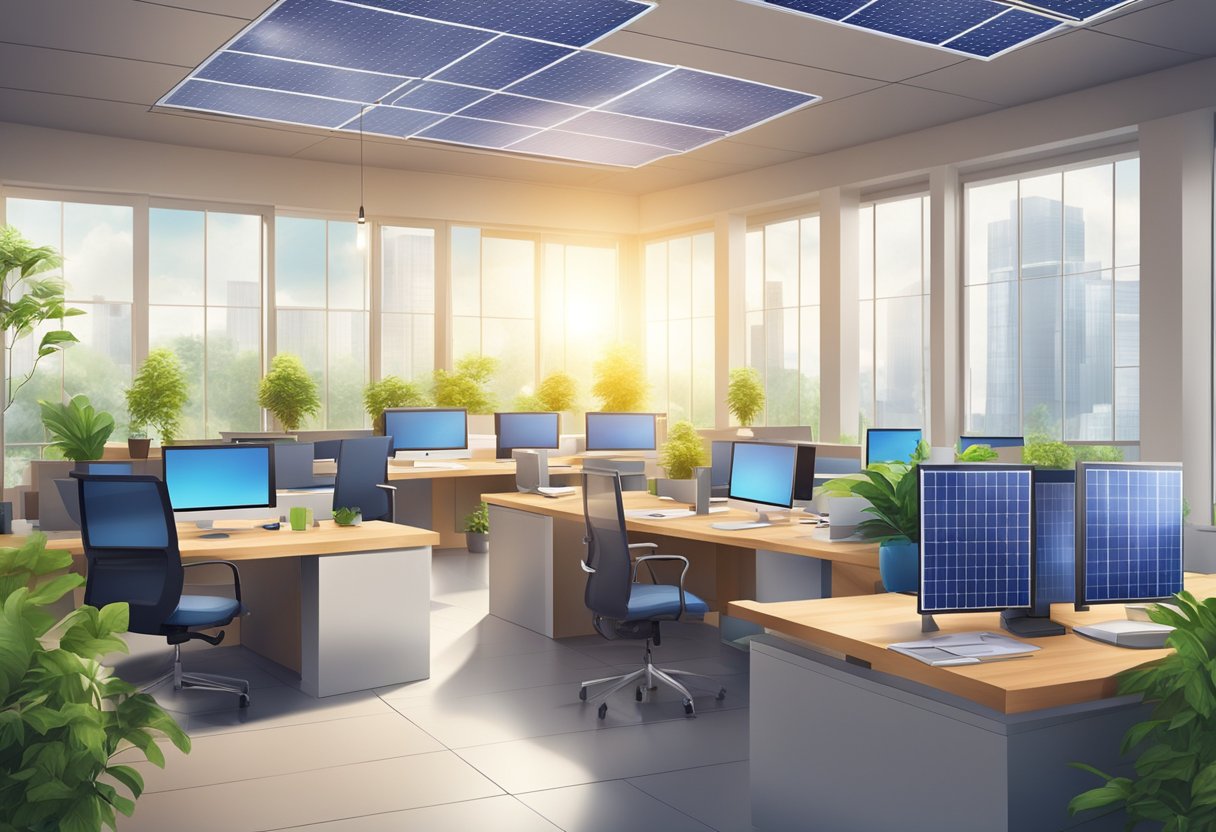Sustainable Customer Service Practices: A Blueprint for Eco-Friendly Support
In the world of business, sustainability has become more than just a trend—it’s a necessary pivot. Companies across various sectors are recognizing the importance of incorporating sustainable practices into all facets of their operations, including customer service. Sustainable customer service isn’t just about reducing environmental impact; it’s also about building a brand that consumers trust and want to support long-term. By integrating eco-friendly measures, businesses are not only doing their bit for the planet but also enhancing their customer relations.

Customers today are increasingly conscious about where they spend their money, supporting businesses that align with their personal values of environmental stewardship. This shift prompts companies to reevaluate how they interact with customers, ensuring that each touchpoint reflects a commitment to sustainability. From using digital communication to reduce paper waste to implementing recycling programs within customer service centers, there are numerous ways for a company to minimize its ecological footprint while maintaining high service standards.
As companies strive to meet the dual demands of high-quality customer service and environmental responsibility, they encounter a unique opportunity to innovate. By embracing sustainable customer service practices, organizations not only contribute positively to the environment but also forge stronger connections with customers who value mindful consumption. In doing so, businesses may find that the journey towards sustainability is not just an ethical choice but a strategic advantage.
Understanding Sustainability in Business

In the realm of business, sustainability is about ensuring long-term success while considering the impact on the environment and society. It’s a way to do good while doing well financially. Here’s a breakdown of what this looks like in practice.
Defining Sustainable Practices
Sustainable practices in business are actions that prioritize not just economic gains but also environmental protection and social equity. These practices include measures like reducing waste, conserving natural resources, and fostering a workplace that supports employees’ well-being. Corporate Social Responsibility (CSR) is a key component of sustainable practices, as companies seek ways to give back to communities and make a positive social impact.
- Resource Management: Meticulous about conserving energy and materials
- Waste Reduction: Committed to recycling and reusing
- Ethical Sourcing: Rigorous in choosing suppliers with similar values
Triple Bottom Line Approach
The Triple Bottom Line (TBL) approach zooms out to evaluate a company’s performance beyond traditional financial metrics. Companies embracing this framework measure success by their impact on people (social responsibility), the planet (environmental sustainability), and profit (economic viability). It’s not just about numbers in a spreadsheet; it’s about how those numbers affect the world we all share.
- People: Ethical labor practices and community engagement
- Planet: Eco-friendly operations and sustainable product life cycles
- Profit: Long-term financial health with ethical investments
By integrating CSR into their core strategies, companies can align their business objectives with sustainable outcomes, resulting in a positive ripple effect on both society and the environment.
The Role of Customer Service in Sustainability
The integration of sustainability into customer service is essential for enhancing customer experience and fostering loyalty. Effective education during customer interactions also plays a critical role in building awareness and engagement.
Incorporating Sustainability into Customer Experience
Customer service departments are increasingly incorporating sustainable practices into their operations, recognizing that customers often make purchasing decisions based on a company’s environmental and social efforts. By doing so, they aim to enhance customer satisfaction and cultivate long-term loyalty. Strategies include using eco-friendly packaging or offering services that emphasize waste reduction. For instance, consider a company that replaces traditional packaging with biodegradable options, significantly cutting down on waste—a move that not only appeals to environmentally conscious consumers but also positions the company as a responsible brand.
- Packaging: Switch to biodegradable, recyclable, or compostable materials.
- Service models: Offer leasing or repair services to extend product lifespans.
Education and Awareness in Customer Interactions
It’s crucial for customer service representatives to be well-informed about their company’s sustainability initiatives. They serve as frontline ambassadors, tasked with the responsibility of educating customers about sustainable product features and corporate social responsibility (CSR) efforts. This communication can help build trust and reinforce the customers’ decision to support the brand. Through thoughtful engagement, service reps can turn everyday interactions into opportunities for raising customer awareness about sustainability issues. This, in turn, often translates into increased customer loyalty to brands that align with their values.
- Educational materials: Provide easy-to-understand content on sustainable practices.
- Dialogue: Engage customers in conversations about sustainability to foster engagement.
Sustainable Products and Services
Companies today face a pressing need to adapt their offerings to the growing market of sustainability-aware customers. This not only involves the innovation of products that minimize environmental impact but also an overall strategy that places eco-friendly options and sustainable products at the forefront of the customer experience.
Promoting Eco-Friendly Options
When companies want to shine in the competitive market, they focus on promoting eco-friendly options that cater to the environmentally conscious consumer. By advertising products with sustainable features, they’re not just selling an item; they’re providing a choice that aligns with the consumer’s personal values. For instance, a brand could highlight a product’s recyclable materials or its low carbon footprint during production, giving customers transparent reasons to choose their brand over others.
Benefits of Offering Sustainable Products
For businesses, the benefits of offering sustainable products are two-fold:
- Consumer Trust: As evidence by research showing the rise of consumer sustainability demands, building trust through responsible practices can foster loyalty and prompt repeat business.
- Market Differentiation: By offering products that commit to sustainability, businesses can distinguish themselves, tapping into a niche market that prioritizes products like reusable containers over single-use plastics. This differentiation can be a significant strategic advantage.
Marketing Strategies for Sustainable Services
When businesses embrace strategies for sustainable services, they’re not only boosting their brand reputation but also engaging with customers who care deeply about eco-friendly practices. They are leveraging these green principles across marketing campaigns to enhance consumer behavior towards sustainability.
Leveraging Green Practices
To successfully market sustainable services, companies should highlight their eco-friendly initiatives in a way that’s relatable to the consumer. For instance, a brand might focus on using biodegradable packaging which reduces waste and is safer for the environment. They can also champion energy-saving technologies or renewable energy use in their operations, showcasing these efforts prominently in their marketing materials. Transparency is key, and companies should be open about their sustainable journey, including any third-party certifications they’ve earned. By doing so, they are creating a sustainable competitive advantage through trust and shared values.
Consumer Behavior and Sustainability
Understanding and influencing consumer behavior is a critical part of marketing sustainable services. Companies can educate consumers about the benefits of sustainable practices such as supporting local ecosystems or reducing carbon footprints. Marketers can harness the power of stories, showcasing real-world examples of how the service has made a positive impact. In addition, incentives for eco-friendly behavior, like discounts for using reusable containers or membership points for participating in environmental initiatives, can further align consumer actions with sustainability goals.
Leveraging Technology for Green Customer Service

In today’s digital era, companies are increasingly turning to technology to drive sustainability in customer service. By prioritizing efficiency and adopting cleaner production methods, firms are not only reducing their environmental footprint but also enhancing customer satisfaction.
Digital Tools and Sustainable Service
Businesses employ various digital tools to provide eco-friendly customer service. Live chat services and virtual assistants reduce the need for paper and in-person meetings, while cloud-based solutions allow for the efficient management of interactions with clients using less energy compared to traditional on-premises systems. The integration of AI into customer service operations improves response times and provides 24/7 support without the increased energy use of extended operational hours.
For example:
- Customer Relationship Management (CRM) systems help companies track customer interactions efficiently, often resulting in fewer errors and reduced resource consumption.
- Data analytics tools aid in understanding patterns in customer behavior, allowing for a more tailored service that can anticipate needs and minimize waste.
- Remote diagnostics can solve customer issues without a technician having to travel, which cuts down on emissions.
By harnessing these technologies, service becomes not only more sustainable but also often more responsive and personalized, aligning with modern consumer expectations for both green practices and seamless service.
Building Customer Loyalty with Sustainability

Sustainable customer service practices can be pivotal in fostering strong customer loyalty. By aligning a brand’s sustainability values with customer expectations, companies can create more meaningful relationships with their clients.
Rewards for Eco-Conscious Behavior
Companies can incentivize eco-conscious behavior by offering loyalty points for customers who make sustainable choices. This could include rewards for:
- Using reusable containers: For each drink a customer buys with their own mug or tumbler, they earn points.
- Recycling packaging: Customers who return packaging for recycling get a discount on their next purchase.
These rewards serve as a dual benefit by cementing customer loyalty while also promoting a more sustainable business model.
Customer Relations and Environmental Stewardship
The relationship between a company and its customers can be strengthened through shared environmental goals. Some strategies include:
- Transparent communication: Companies should openly share their sustainability efforts, such as reducing carbon emissions, which can increase consumer trust.
- Collaborative initiatives: Inviting customers to join clean-up drives or sustainability workshops helps them feel part of the company’s environmental mission.
Through these relationships, companies not only bolster customer loyalty but also work toward a healthier planet, creating a win-win scenario for all stakeholders involved.
Sustainability and Corporate Reputation

When companies integrate sustainability into their business model, they notice a positive impact on their corporate reputation. Sustainable practices are not just socially responsible; they contribute to building a strong and trustworthy brand.
Transparency and Accountability
Transparency is critical for companies that want to be seen as sustainable. Customers expect access to information about how products are sourced, made, and delivered. They also look to see if a company’s sustainability claims hold water. For instance, when a company shares details about its supply chain or publishes sustainability reports, it not only meets these expectations but also strengthens its reputation.
Accountability goes hand in hand with transparency. Companies that set clear sustainability goals—and then report on their progress—build credibility. Customers and industry peers alike respect a brand that doesn’t just talk about sustainability but also puts in the work and hold themselves accountable for their environmental footprint.
The Economics of Sustainable Service

Blending profit and environmental stewardship can give businesses a competitive edge. Sustainable service practices are not just beneficial for the planet, they’re becoming a cornerstone in savvy financial strategies.
Profit and Environmental Responsibility
Sustainability and profitability are not mutually exclusive. In today’s market, they often go hand in hand. For example, when companies invest in eco-friendly materials or processes, it may involve upfront costs, but this can lead to substantial savings in waste disposal and energy. Moreover, they’re tapping into a growing segment of consumers prioritizing sustainability, potentially increasing sales and customer loyalty.
Cost-Saving Approaches in Sustainability
Efficient resource management within the circular economy model reduces costs while promoting sustainability. By designing products for reuse, repair, and recycling, companies are able to keep materials in circulation longer, which can defer the cost of raw materials and decrease expenses associated with waste management. Efforts like utilizing renewable energy sources and water-saving techniques can substantially lower utility costs over time.
Sustainability Through Partnerships and Innovation

Crafting sustainable customer service doesn’t just stop at recycling or using energy-friendly lighting. It’s about forging solid partnerships and pioneering business models that embed sustainability into the heart of services.
Collaboration for Sustainable Development
When companies team up, they can amplify their impact on sustainability. A practical framework for partnering with customers ensures long-lasting collaborations which mutually benefit all stakeholders involved. These partnerships prioritize joint efforts in innovation, centering around a customer-focused strategy that meets demand while respecting our planet.
Business Model Innovation
A shift in business models is critical for sustainable development. It involves rethinking corporate strategies to create eco-friendly solutions. Companies can drive growth and foster sustainability by using natural resources wisely, optimizing energy use, reducing waste, and focusing on circular economy principles. These innovative approaches offer a valuable competitive advantage while contributing to a healthier environment.
Engaging the Next Generation in Sustainability

The next generation of consumers is pivotal in shaping a sustainable future, wielding considerable influence through both spending power and social engagement.
Millennials and Gen Z as Drivers of Change
Millennials and Gen Z are not just passive shoppers; they’re change-makers who prioritize sustainability in their purchasing habits. These demographics are more likely to support brands that demonstrate a commitment to the environment. Their consumer behavior reflects a desire for transparency and ethical business practices. They’re pushing companies to reduce carbon emissions and minimize waste generation through responsible sourcing of materials.
The Role of Social Media in Sustainable Service
Social media isn’t just where memes go viral; it’s where sustainable practices can flourish. Gen Z and millennials often use platforms like Instagram and Twitter to share their eco-friendly purchases and to spread the word about brands that are doing right by the planet. This word of mouth isn’t just chit-chat—it drives trends and puts pressure on companies to commit to green practices, making it a powerful tool in sustainable customer service.
Frequently Asked Questions

In this section, readers find answers to common queries about integrating sustainability into customer service, to enhance both environmental impact and customer satisfaction.
What are some real-world examples of sustainable customer service?
Companies like Patagonia and IKEA are spearheading the movement by offering repair services and taking back used items. They show that a commitment to sustainability can coexist with outstanding customer service, reducing waste and fostering customer loyalty.
How does sustainability factor into enhancing customer experiences?
Initiatives like offering eco-friendly packaging or incentivizing the return of products for recycling can significantly enhance the customer experience. Customers feel their choices contribute to a positive environmental impact, which can elevate the overall perception of the brand.
What role does sustainability play in the hospitality sector’s customer service?
Hotels and resorts are increasingly incorporating sustainable practices such as local sourcing of food and materials, reducing plastic use, and encouraging towel reuse. These actions reflect a commitment to the planet that increasingly resonates with travelers, potentially increasing guest satisfaction and repeat business.
Can sustainable business practices really boost customer satisfaction levels?
Yes, sustainable practices can create a sense of pride and fulfillment among customers, who are happy to support brands that align with their values. This can elevate the customer’s overall satisfaction with a company.
What sustainable strategies can companies adopt to maintain consistent customer satisfaction?
Companies can adopt strategies like reducing carbon footprints, utilizing renewable energy, and creating products with sustainable materials. By clearly communicating these practices, a brand can maintain high levels of customer satisfaction and attract like-minded consumers.
In what ways do consumers show they value sustainability in the businesses they support?
Consumers often show they value sustainability by choosing businesses that have clear sustainability credentials, provide transparency in their supply chains, and offer products or services that help reduce the environmental impact. Customer loyalty may increase as a result of these shared values.


